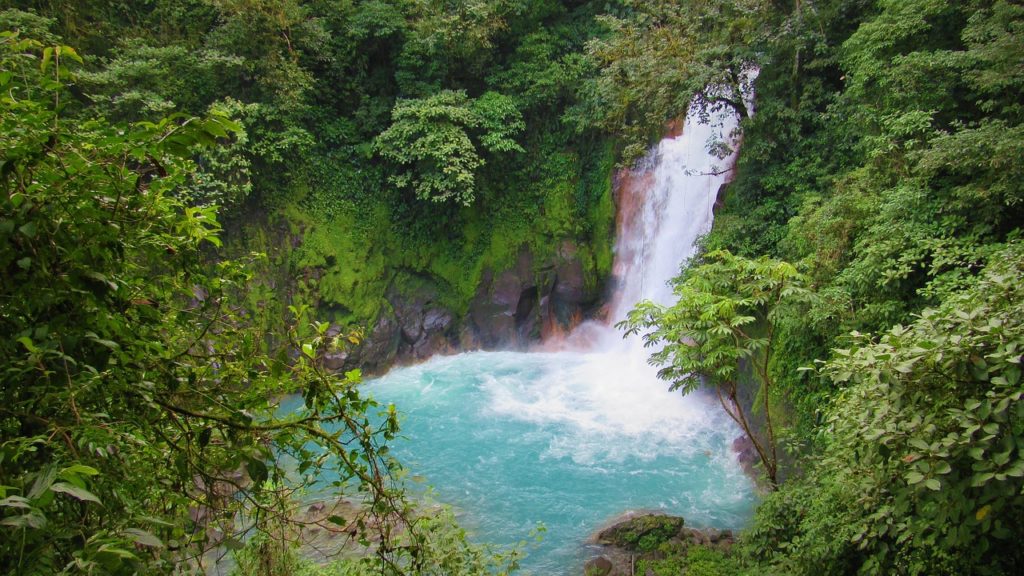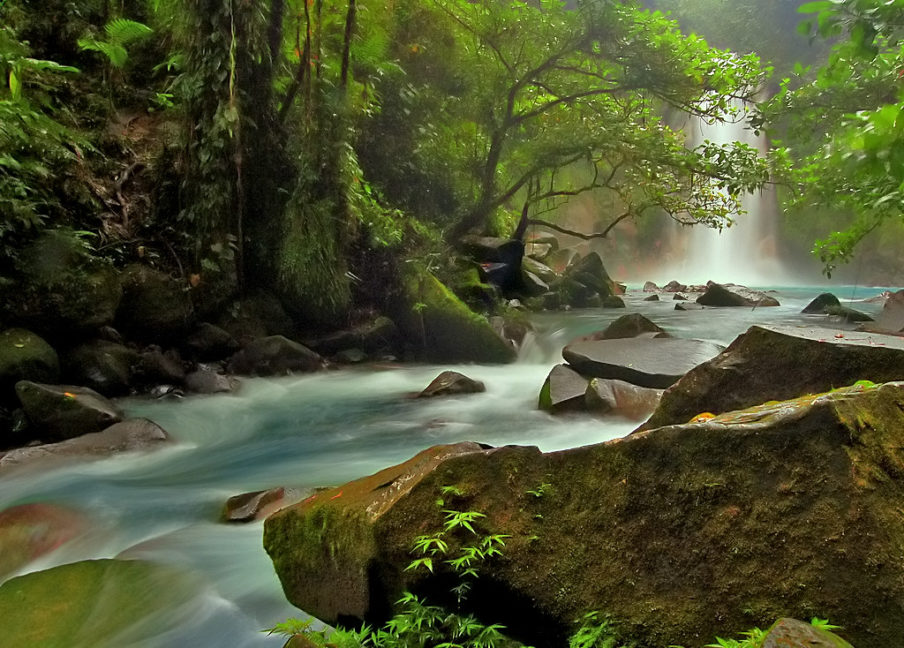
This popular attraction offers a unique and stunningly beautiful turquoise blue river that is located in the Tenorio Volcano National Park. Rio Celeste translates to “Light Blue River” in Spanish and it is one of the most sought after places to visit in Costa Rica.
The natural phenomenon is created by the mixing of two streams that contain minerals that create the stunning color that draws in visitors from all over the world. This guide will provide you with all the information you need to know to make the most of your visit to Rio Celeste.
Getting to Rio Celeste
Rio Celeste is located in the Tenorio Volcano National Park, which is situated in the northern part of Costa Rica. The nearest town is Guatuso, and the closest major city is Liberia. The best way to get to Rio Celeste is by car, as public transportation is limited in the area.
From Liberia
To get to Rio Celeste from Liberia, you can take a scenic drive through the lush Costa Rican countryside. The journey starts by heading east on Route 21 towards Upala, covering a distance of approximately 48 kilometers (30 miles). As you drive, you’ll pass by picturesque landscapes and small towns that are characteristic of the Guanacaste province.
After 48 kilometers (30 miles), you will turn left onto Route 6 and continue for about 19 kilometers (12 miles).
Next, you will turn right onto Route 4 and continue for approximately 9 kilometers (5.6 miles). This stretch of the journey will take you through more scenic countryside before you reach the turnoff for Route 794.
Turning left onto Route 794, you’ll drive for about 13 kilometers (8 miles) before reaching the entrance road for Tenorio Volcano National Park.
Finally, you’ll drive for approximately 8 kilometers (5 miles) on the entrance road until you reach the parking area for the Rio Celeste waterfall. The total driving distance from Liberia to Rio Celeste is approximately 95 kilometers (59 miles), and the journey takes around 2 hours.
From San Jose
Driving to Rio Celeste from San Jose is a beautiful and scenic journey, but it’s important to be prepared for the narrow and winding mountain roads. From San Jose, head north on Route 1 towards Liberia. Take the exit towards Canas and continue on Route 1 until you reach the intersection with Route 6 towards Upala.
Follow Route 6 for approximately 45 kilometers until you reach the entrance to the Tenorio Volcano National Park, where Rio Celeste is located. The last 10 kilometers of the road leading to the park entrance can be bumpy, so it’s recommended to rent a four-wheel-drive vehicle for a more comfortable ride.
While road signs are limited, the locals are friendly and can provide directions if needed. It’s recommended to drive during daylight hours, fill up on gas and supplies beforehand, and check weather conditions before embarking on the journey to Rio Celeste.
The drive from San Jose to Rio Celeste takes approximately 3.5 to 4 hours.
What to do at Rio Celeste
Rio Celeste offers visitors a variety of activities to enjoy, from hiking the surrounding trails to soaking in the river’s natural hot springs. Here are some of the top things to do at Rio Celeste:
Visit the waterfall (of course)
The Rio Celeste waterfall is the highlight of the park and is one of the most photographed natural wonders in Costa Rica. The waterfall’s vibrant blue color is truly a sight to behold.
To get to the waterfall, visitors must hike the Rio Celeste Trail, a 3.7-mile (6 km) round trip hike that takes about 3-4 hours to complete. The trail can be challenging in some sections, but is well-maintained and marked. Visitors should wear sturdy hiking shoes, comfortable clothing, and bring plenty of water and snacks.
Once at the waterfall, visitors can admire its stunning light blue color and take photos from several viewing areas. Swimming is not allowed in the waterfall due to its ecological sensitivity and for safety reasons, but visitors can swim in the nearby natural hot springs, which are said to have therapeutic properties.
It’s recommended to visit during the dry season (December to April) when the water is clearer and the light blue color is more vivid.
Hiring a local guide is highly recommended, as they can provide information about the area’s ecology, wildlife, and cultural significance.
Hiking Trails
Rio Celeste offers several hiking trails for visitors to explore the park’s stunning natural beauty. Here are some of the trails that you can find in Rio Celeste:
1 Rio Celeste Trail
This is the most popular trail in the park, leading visitors through the rainforest to the river’s light blue waterfall, which is the highlight of the park. The trail is approximately 3.7 miles (6 km) round trip and takes about 3-4 hours to complete.
2. Mirador Trail
This trail is shorter than the Rio Celeste Trail and takes visitors to a viewpoint overlooking the Tenorio Volcano. The trail is about 1.8 miles (3 km) round trip and takes about 2 hours to complete.
3. Puma Trail
This trail is longer and more challenging than the other trails in the park, leading visitors through dense rainforest and offering a chance to spot wildlife such as monkeys and sloths. The trail is about 8 miles (13 km) round trip and takes about 6-7 hours to complete.
4. Waterfall Trail
This trail is a short loop that takes visitors to several smaller waterfalls along the Rio Celeste. The trail is approximately 1 mile (1.6 km) round trip and takes about 1-2 hours to complete.
It’s important to note that some of these trails can be challenging, with steep inclines and rocky terrain
Relax in the hot springs
There are several natural hot springs near Rio Celeste that are perfect for a relaxing soak after a day of hiking. These natural hot springs are located within the park and are said to have therapeutic properties due to their mineral content.
You can relax in the warm water while surrounded by the lush rainforest, creating a peaceful and rejuvenating experience. The hot springs are accessible via a short hike from the park’s entrance, and visitors can rent towels and lockers at the site.
It’s important to note that the hot springs can be crowded during peak season, so it’s recommended to arrive early to avoid the crowds.
Birdwatching
Rio Celeste is home to a variety of bird species, making it a popular destination for birdwatchers. The park’s rainforest habitat provides a rich ecosystem for birdlife, with over 300 species recorded in the area. Visitors can spot birds such as toucans, trogons, and tanagers, among others.
The Puma Trail, in particular, offers a great opportunity to spot birds, as it leads visitors through dense rainforest and offers a chance to observe birdlife in its natural habitat. Hiring a local guide is highly recommended, as they can provide information on the different bird species and their behavior, making it easier to spot them.
Don’t forget to bring binoculars, a field guide, and wear muted colors to avoid startling the birds.
Indian Culture
Located near Rio Celeste is the Maleku Indigenous Reserve, home to the Maleku people, one of the indigenous groups in Costa Rica. The reserve offers visitors a unique opportunity to learn about the Maleku culture, traditions, and way of life. You can participate in cultural activities such as basket weaving, pottery, and traditional dance performances.
The Maleku people also offer guided tours of the reserve, where visitors can learn about the medicinal plants and the significance of the surrounding wildlife. The reserve also features a museum dedicated to the Maleku culture, showcasing traditional clothing, tools, and artifacts.
Tips for visiting Rio Celeste
Here are some tips for visiting Rio Celeste
Wear appropriate clothing
The climate around Rio Celeste is humid and tropical, so wear lightweight and breathable clothing. Sturdy hiking shoes and a rain jacket are also essential.
Protect yourself from the sun
The sun can be intense in the area, so don[t forget to wear sunscreen, a hat, and sunglasses to protect yourself.
Hire a local guide
Hiring a local guide is highly recommended, as they can provide information on the area’s ecology, wildlife, and cultural significance.
Visit during the dry season
The dry season, which runs from December to April, is the best time to visit Rio Celeste as the water is clearer and the light blue color is more vivid.
Be prepared for a challenging hike
The Rio Celeste Trail can be challenging in some sections, so it’s recommended to be in good physical condition and wear appropriate footwear.

